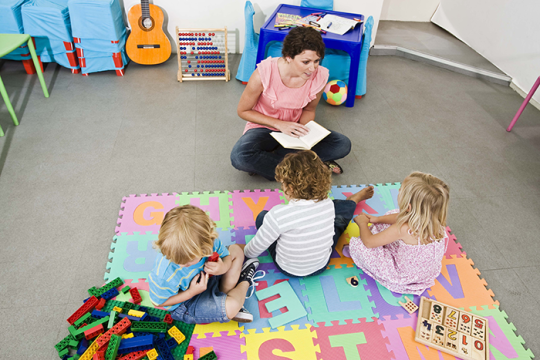Picture this scene: 3rd grade students learning about the Negev desert as part of their Israel unit enter a classroom, which has been transformed into a Bedouin tent. They practice the Mitzvah of welcoming others by handing out tea and acting out short conversations welcoming others in Hebrew. The students hear the biblical story of Abraham and the visit of the three angels at his tent in Hebrew, and learn about Ben Gurion moving his whole life to a small kibbutz in the desert to make the desert bloom. They finish by making their own tiny greenhouses and planting sprouts in them to learn about Negev culture – in Hebrew.
This is Kashkesh, the immersive Hebrew language program created by Congregation Kol Ami of Westchester, which invites young children in grades K-3 to learn Hebrew in a friendly, cheerful environment through true immersion in the language.
Immersion is considered to be one of the most effective ways to learn a language, and our hope is that students will become familiar with basic terms and phrases that they can use in their homes, in their Jewish lives, and even on the streets of Israel. While many programs provide students with Hebrew immersion, Kashkesh goes further by focusing on using project-based, experiential learning to make the words come alive for our kids and help them put their meaning in context.
The Kashkesh program was born of several conversations. One day, a Kindergarten teacher in our school gave me a ride to the train station. She said she was interested in the experiential, project-based education we had implemented for the youth group and grades 3-6, and was wondering why this kind of learning was not also available to younger children. Coincidentally, and unbeknownst to me, a generous donor approached the principal of the Religious School, and said he was very interested in providing funding for a project related to Hebrew and Israel education. If this was not enough, parents of a group of younger children approached the principal and asked if it would be possible to provide their children with the opportunity to learn more modern Hebrew. It seemed that the faculty, the community and parents at the school had all identified a need – a need for exciting, enriching Hebrew learning. It was a fortuitous moment: we were able to figure out exactly what people in the community wanted and had resources in terms of funding, time and staffing to make this happen. We designed Kashkesh to achieve a few disparate goals:
- To provide our students, who had been learning primarily prayer-based written Hebrew with the opportunity to have enrichment in spoken, modern Hebrew.
- To use the arts throughout the curriculum to bring learning to life.
- To design an age-appropriate curriculum that draws on themes we thought would be compelling to the community: The Jewish Home, Holidays and Israel.
What was particularly interesting was that Kashkesh really grew out of a desire voiced by different members of the community. In order for it to come to life, we received feedback in conversations with teachers and parents and obtained special funding from our donor. It was amazing to witness the community that came out of the Kashkesh program. Consistently, this has been an extremely involved, highly motivated group of families. Parents respond to weekly e-mails and track their children’s progress eagerly. They seek opportunities to reinforce learning at home. Since the class is held after regular religious school hours, parents who have a child in the program wait an hour to pick up their kids, many of them opting not to leave and come back but instead choosing to stay and mingle with each other. One parent wrote in the school newsletter, describing these Sunday afternoons making connections with other families as one of the unexpected highlights of the program. Kashkesh has been incredibly rewarding and has brought up many points for me as an educator.
First, it is invaluable when we can identify and respond to the needs of a community through creative curriculum design. Second, I was actually surprised how quickly and how much the students learned. Initially, I was not quite sure how high we could raise our expectations. But as the year draws to an end, we are hearing from teachers that students in the Kashkesh program are advancing much faster than their peers in Hebrew. In class, these kids who have never heard Hebrew before are now able to understand basic stories in Hebrew and many words. Consistently, the thing that has made a difference in this regard was the motivation of both students and parents to learn. The students have enjoyed the interactive, project-based nature of the program and are eager to come to class on Sundays. But what is most amazing was how parents partnered with me to reinforce learning at home. Part of the way we made this happen was to provide parents with weekly e-mails describing what was learned in class, and actually attaching all handouts. Many of the parents are learning along with their kids, and collecting the handouts to compile a personal vocabulary that grows each week.
Recently, a parent approached me after class to let me know that she feels her son, who goes to a bilingual school, is learning more Hebrew in our Kol Ami class than he does Spanish at school. Teachers in the third grade have reported students in the program are advancing significantly faster than their peers and their skills exceed the level at which their peers are learning. As our first year of Kashkesh draws to a close, this feedback helps me to know that we are on the right track. It is this kind of high-energy, immersive learning that gets students and parents excited about their Jewish education. As this year draws to a close, we are excited to begin our plans to expand our pilot for Hebrew learning into all our Kindergarten through 2nd grade classes.
It is our hope that exposure to Hebrew, with project based learning through art, dance and music will form the foundation for early Hebrew language learning, while also giving our students a taste of the modern language of Hebrew.
Learn more about Congregation Kol Ami and the Kashkesh program on their website.
Related Posts

Showing Congregational Educators That You Value Their Work

Shalom LinkED: An Educational Opportunity for Your Congregation
